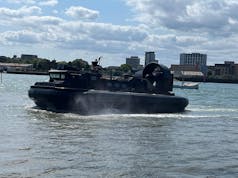Finning UK is providing main engine degaussing to four of the Royal Navy’s Hunt class mine countermeasures vessels.
Reducing the magnetic signature of a vessel, degaussing is essential to help defend the Hunt class from mines.
With the existing system for the Hunts now requiring an upgrade, the installation of new degaussing coils and ancillaries by Finning ensures the main engines emit a low electromagnetic field at all times.
With each of the ships fitted with a set of twin Cat C32 ACERT marine propulsion engines, the degaussing equipment will fit directly onto the engine’s mounting rafts, either held in place by brackets or attached directly onto the engine’s framework.
The new system has been designed in conjunction with Babcock International.
Christopher Shotton, Project Manager at Finning, explains:
“The Hunt Class are the Royal Navy’s biggest single-hulled warships to be made from glass-reinforced plastic (GRP). The GRP hull allows the ship to maintain a low magnetic signature, which plays a critical role in keeping the ships safe from mines that can detect and target conventional metallic hulls. However, this design offers limited protection from any radiated emissions.
Therefore, the engines must produce a very low electromagnetic field so they do not affect the overall ship’s signature.
By working with Babcock International, we have created a degaussing system that helps significantly lower the magnetic field from the propulsion engines, effectively neutralising it. This technology will help deliver vital protection to the Royal Navy’s Hunt Class warships.
The testing of the new equipment has gone smoothly and installation audits are now complete, and we have begun fitting the solution onto the warships’ engines. Having worked with the Hunt Class since 2010, we are delighted to continue developing innovative and intelligent technology solutions for these important Royal Navy vessels.”
The degaussing coils have been fitted to HMS Middleton’s engines and have been successfully proven on the vessel during a whole ship magnetic ranging trial. The technology will then be supplied to HMS Cattistock, HMS Chiddingfold and HMS Brocklesby – whose upgrade will need to be completed while the vessel is in service in a joint operations area.













So now the RN will have a grand total of 12 MCM ships. Pathetic.
The USN has 14 wooden hulled boats.
Yes the USN use Helos but they don’t hunt mines… They can only sweep.
The RN boats deliver far more OC than the USN Avenger class.
That’s great, but the RN had 24 MCM ships not that long ago.
If by some miracle MoD decided to increase these assets could the old HMS Brecon still be re commissioned? Hunt vessel now used as Dartmouth Training vessel.
Most of the Hunts and Sandown that are used as alongside class rooms are hollow shells with the meaningful equipment removed.
The hulls will be in good condition though as thats one of the joys of using GRP. Maybe some osmosis issues if the paint scheme is not renewed but the hulls will last at least 30-50 years easily.
Thank’s Gunbuster. So not impossible but still some cost to reactivate.